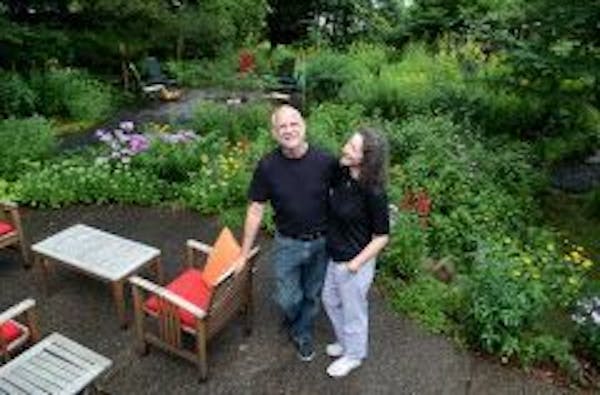Keeping pests away — naturally
Jeremy Mayberg is committed to keeping his garden free of chemical insecticides and pesticides, to support the birds, butterflies and bees that dart among his native plants.
He keeps on top of pesky insects with a kitchen remedy: combining liquid dishwashing soap and water in a spray bottle and dousing the aphids he finds.
"They turn black and die," he said. "Aphids especially like height; the compass plant is full of them."
To keep rabbits away, he relies on a natural elixir that sounds more suited to killing vampires than deterring bunnies. He sprinkles a mixture of dried blood meal and garlic that he found at his neighborhood hardware store.
"Last year a lot of my hostas were eaten down to the nub. This year they're thriving, so it's working," he said.
Although Mayberg's wife, Amy-Ann, is charmed by the chipmunks that make their home in the garden, Mayberg is not a fan.
"They're destructive. They could undermine the patio," he said. "I yell at them a lot. We coexist."
Ever-changing colors
Mayberg thrills to the sight of buds, knowing each will give way to a pop of color. He savors watching the palette shift with each warm-weather month.
"I say I paint with plants," he said.
In May, the showy pasqueflower, waxy-white with a large yellow button center ("my Georgia O'Keefe flower"), is the first to open, but shades of pink then dominate the yard for the month, with the magenta of the chalice-shaped poppy mallow blooming alongside the vivid near-crimson of the penstemon beardtongue.
In June, the garden gives way to varieties of green.
"Green gets overlooked," Mayberg said.
Orange hues are prominent in July, with bright butterfly weed and coneflowers, and yellows and purples take over in August, from the lemon-colored cup flower to the delicate lavender of the nodding onion.
"When the purple New England aster opens, it's bittersweet. ... When I see it, I know summer is over."
Native characteristics
Mayberg's prairie plants don't flatten in a stiff breeze. Instead, they nod.
The native flowers stand tall because many of them are staked and hooped; Mayberg has a knack for camouflaging the stabilizing structures that keep his plants perky.
"When the wind blew on the prairie, it knocked the plants over. Maybe no one saw them out in the wild, but we see them here and I want them to look good," he said.
To that end, he's continually busy with pruners and scissors, roaming the garden for hours all summer to trim and tame his handiwork and keep its unruliness at bay.
Over the centuries, native plants evolved in the wild without much human touch. Today, anyone wanting to incorporate the sturdy plants into their garden will have to transplant them.
Mayberg advises keeping a spade handy when moving or replanting prairie grasses and flowers.
"They have very deep roots; their survival depended on the ability to suck moisture," he said. "They need to be watered in the first year, but once they are established, nature takes its course. The coneflower has taproot that goes 6 feet down."
The dividend of the long roots is that they relieve native gardeners of watering chores.
"I like plants that thrive on neglect, and nothing thrives on neglect like prairie plants. I water my garden once all summer."
The garden's future
Just as Jeremy and Amy-Ann Mayberg inherited their garden, they know that someday it will pass to another homeowner.
"A garden like this could be a miracle to someone who loves it like we do," he said. "To someone else, it could be viewed like some people see a swimming pool — a nuisance to get rid of."
His garden could survive and thrive without the level of daily attention that he lavishes on it, he noted.
"You could spend maybe three weekends at the beginning of the season; it needs a big spring cleanup," he said. "Then one work weekend in the fall. You could basically neglect it beyond that. The dominant plants would take over — there would be a lot more black-eyed Susans."
At 70, Mayberg has no plans to leave his home and credits his garden with keeping him fit and focused.
"I'm doing what I always wanted to do, to be outside in nature. I believe I will live longer because I do this," Mayberg said. "It's a regenerative environment."
"He has a youthful mind-set, and the garden gets him excited in the way that children get excited," his wife added. "He is completely immersed, covered in sweat and dirt, like a little boy who doesn't want to come in when it gets dark."
KEVYN BURGER
